Do you know that feeling when you hear what’s meant to be a compliment from someone, but there’s something wrong with it?
For instance, if you’re a woman and a scientist, and someone reacts to that with: “You’re a scientist? Wow!”
It was meant to be a compliment — but, it just doesn’t sit right with you.
That’s because what you’ve experienced is called a microaggression.
In this blog post, we will:
- Clearly define microaggressions,
- Introduce you to different types of microaggressions and provide examples to illustrate them,
- Discuss the impact of microaggressions in the workplace, and
- Provide helpful tips on how to deal with microaggressions.
Let’s get started!
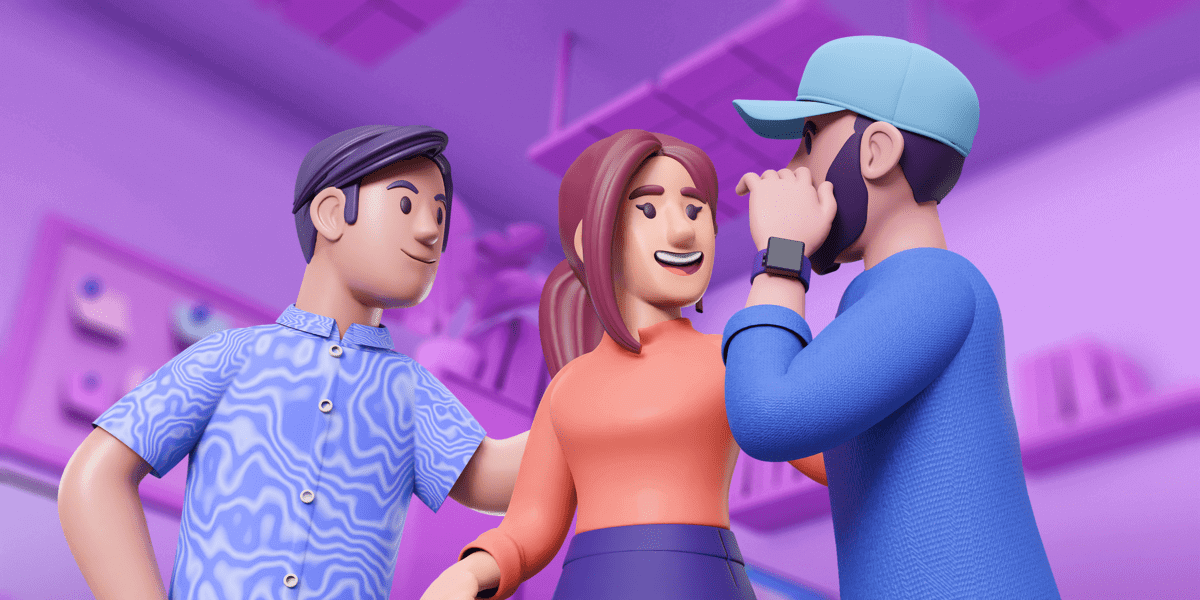
- Microaggressions are seemingly harmless and often barely noticeable behaviors or comments that carry derogatory or offensive messages to individuals or communities based on a specific aspect of their identity.
- We can recognize 3 main types of microaggressions — microassaults, microinsults, and microinvalidations.
- Microaggressions further fall into 1 of 3 broader categories, so they can be verbal, environmental, or behavioral.
- Microaggressions at work can lead to various negative consequences on the employees’ physical and mental health, including increased anxiety and chronic stress.
Table of Contents
What are microaggressions?
Microaggressions are seemingly harmless and often barely noticeable behaviors or comments that carry derogatory or offensive messages to individuals or communities based on a specific aspect of their identity.
In his book Microaggressions in Everyday Life, Derald Wing Sue provides a similar definition of microaggressions, writing that they are “brief, everyday exchanges that send denigrating messages to certain individuals because of their group membership.”
The subtle nature of these actions means they sometimes go unnoticed, but they can significantly impact the targeted person’s emotional well-being and overall work performance.
As microaggressions constitute harmful acts toward any marginalized group, people may find themselves at the receiving end of microaggressive behavior because of their:
- Race,
- Gender,
- Age,
- Sexual orientation,
- Socioeconomic class,
- Citizenship status,
- Disability, or
- Religion.
Microaggressions are often tied to our unconscious biases, so recognizing and challenging them can be tricky.
Although we may consciously endorse egalitarian values, we could still harbor negative feelings towards marginalized groups unconsciously.
However, becoming aware of the different types of microaggressions is a crucial first step towards addressing these biases.
💡 Pumble Pro Tip
To read up on unconscious and cognitive biases in the workplace and learn how to address them, check out these blog posts:
Types of microaggressions
We can recognize 3 main types of microaggressions:
- Microassaults,
- Microinsults, and
- Microinvalidations.
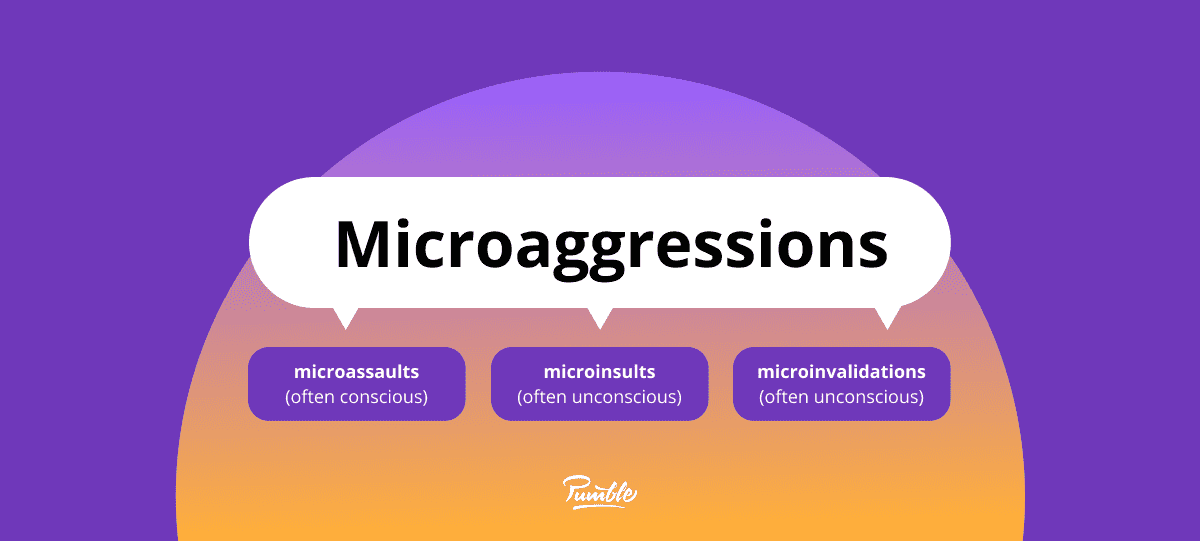
The above types fall into one of the 3 broader categories, which are:
- Verbal microaggressions: They’re often phrased as well-meaning comments and questions but are laden with hidden meanings. For example, asking a US citizen with a minority background where their “real home” is only reinforces negative assumptions.
- Behavioral microaggressions: They are also called nonverbal microaggressions because a person can deliver a hurtful and denigrating message through their actions.
- Environmental microaggressions: They create a hostile environment that makes a specific community feel unwelcome. Most often, examples of environmental microaggressions are structural and institutional because buildings and infrastructure pose hostile architectural barriers that cause difficulties for particular groups. For instance, placing small bumps on park benches is, in some places, used to discourage the homeless population from sleeping there.
Now, let’s dive a bit deeper into the 3 main forms of microaggressions and what each of them means.
Type #1: Microassaults
Microassaults are the only conscious microaggressions.
They involve explicit derogations directed toward a member of a marginalized group.
Since they are conscious, their intention is to hurt the victim through name-calling or discriminatory actions.
Of all the types of microaggressions, microassaults are the easiest to recognize.
Let’s take a look at some examples of microassaults.
| Verbal microassaults | Behavioral microassaults | Environmental microassaults |
|---|---|---|
| Referring to: ❌ Japanese Americans as “Japs” | ❌ Forbidding a son or daughter from marrying outside of one’s race | ❌ Displaying a Nazi swastika |
| Referring to: ❌ Women as “females” | ❌ Ignoring a group of women who are requesting a table at a restaurant | ❌ Excluding people of color from meetings for no apparent reason |
| Referring to: ❌ Gay men as “fruity” | ❌ Promoting a less-qualified heterosexual employee over a gay one | ❌ Hanging Playboy bunny pictures in a male manager’s office |
Type #2: Microinsults
Microinsults involve making comments or taking actions that communicate insensitivity to or disregard for a person’s identity.
They are more subtle than microassaults, and perpetrators are often unaware that they are hurting other people.
Let’s illustrate this with a few examples of microinsults.
| Verbal microinsults | Behavioral microinsults | Environmental microinsults |
|---|---|---|
| ❌ When a male teacher expresses surprise at the math skills of a female student: “Wow, how did you get so good in math?” | ❌ A White woman who clutches her purse more tightly in the presence of Latinos | ❌ When women in the workplace enter a conference room where portraits of all the past male CEOs or directors are displayed |
| ❌ Saying to an African American: “You’re a credit to your race!” | ❌ A White man checking for his wallet while passing a group of African Americans on the sidewalk | ❌ Television shows and movies that feature predominantly White heterosexual people, without representation of people of color or the LGBT+ population |
| ❌ Saying to an Asian American: “You speak English so well!” | ❌ A female physician at an emergency room is mistaken by male patients for a nurse | ❌ The scarcity of professors and mentors of color at a university |
Type #3: Microinvalidations
Microinvalidations are any comments, behavior, or environmental messages that exclude, negate, or nullify the thoughts, feelings, or identity of a person from a marginalized group.
Just like with microinsults, the perpetrators of this type of microaggressions are usually unaware of what they are doing.
However, the lack of intent to hurt other people doesn’t mean that the targets are not hurt, which is why it’s all the more important to raise awareness about them.
Take a look at a few examples of microinvalidations.
| Verbal microinvalidations | Behavioral microinvalidations | Environmental microinvalidations |
|---|---|---|
| ❌ Asking a person who struggles with mental health: “You have a disability? You seem perfectly normal to me.” | ❌ Mistaking people of the same race | ❌ When a Black employee starts to work in a company with only White employees |
| ❌ Asking an Asian American with a perfect English accent:“So, where are you really from?” | ❌ A male colleague asking his female peer to take notes and order lunch for the team | ❌ Holding a meeting in a language not all meeting participants speak |
| ❌ Saying to an African American woman: “I don’t see color. We’re all human beings.” | ❌ Assuming that everyone in the workplace celebrates Christmas | ❌ Not using gender-sensitive language in job ads, thereby deterring women from applying to them |
Examples of microaggressions at work
Although someone may have good intentions, they might still commit microaggressions because they don’t understand the repercussions of their actions and words.
Microaggressive scenarios can lead to unresolved conflict or tension at work, and the negativity only grows when people fail to recognize microaggressive acts for what they are.
For this reason, we’ll explore some examples of microaggressions in the workplace.
Examples of verbal microaggressions at work
Subtly bringing up a person’s age with statements like “Funny you’ve become a supervisor at such a young age!” and “You’re not too bad with electronics for someone your age!” is a dig at their competence.
These comments are backhanded compliments that imply someone’s capability is directly related to their age.
Similarly, racial microaggression can also play out in the office. For instance, seeking help from a colleague with Asian heritage when solving a tech issue can be problematic — especially if other people are far more qualified to deal with the situation.
Consequently, remarks such as “People like you are so good at IT and science” reinforce the stereotype that all Asian people are “smart nerds.”
That’s why reading the below example in Pumble, a team communication app, feels awkward. While Joseph might truly have no ill will toward Anna, we can clearly recognize the microaggressive undertones.
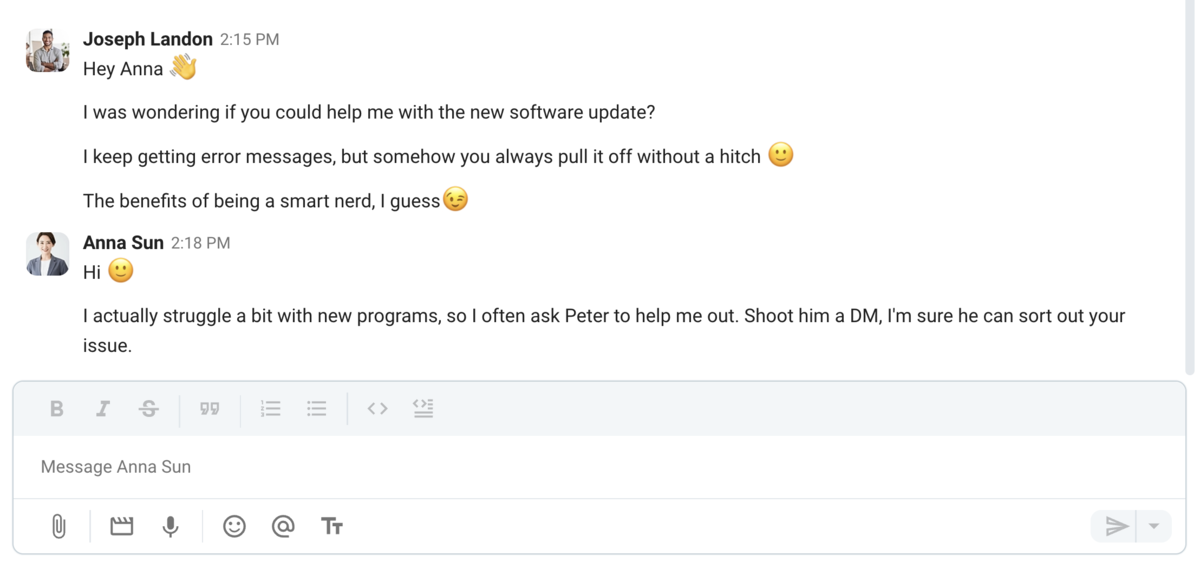
Practice effective communication over Pumble
Examples of behavioral microaggressions at work
Putting your belongings in the drawers of your work desk when a colleague with a Middle Eastern background is around is a behavioral microaggression.
The act brings into question the coworker’s trustworthiness and signals to onlookers that they may be a potential threat.
Another microaggression example would be discouraging a female employee from pursuing a managerial position by saying:
“The new position requires working longer hours, and although you work hard, I’d hate to see you spend less time with your family. I know how much you value spending time with your kids.
Also, you’d have much less contact with the customers if you were to become a manager. That’d be a shame since you have excellent communication skills and I’d hate to see such a pretty woman do only behind-the-scenes work.”
Examples of environmental microaggressions at work
Decorating the office walls with pictures of famous figures who have made inflammatory statements about minority groups creates a toxic work environment.
Additionally, a hostile atmosphere may arise when several managers dress up in culturally insensitive costumes (for example, blackface) for the office Halloween party. Because of their position within the organization, some employees may feel apprehensive about speaking up.
💡 Pumble Pro Tip
To learn how to empower all employees and allow them to thrive in the workplace, see this thorough blog post:
Effects of microaggressions in the workplace
Did you know that, according to this study on microaggressive behavior in the workplace, 45% of workers would be upset if being addressed unprofessionally (which is a form of microaggression)?
Aside from that, around 30% of workers would consider leaving their jobs because of these microaggressions.
So, the “micro” in “microaggression” doesn’t mean that the impact of these assaults, insults, or invalidations is small.
Maybe one or two microaggressions are nothing alarming, but the trouble is that they are an everyday occurrence for members of marginalized groups.
That is precisely why their cumulative effect is not to be disregarded.
Moreover, it’s also called “death by a thousand cuts” because the microaggressions pile up slowly and painfully.
So, let’s see what their impact on the workplace is.
#1: Negative impact on employees’ health
Microaggressions at work can lead to various negative consequences on the employees’ physical and mental health.
According to research on microaggressions and traumatic stress, there is a strong correlation between microaggressive behavior and depression.
Aside from that, microaggressions lead to other health problems, such as:
- Increased anxiety,
- Chronic stress,
- Headaches,
- Difficulties with sleep, and
- High blood pressure.
These all disrupt the work environment, decreasing task performance and increasing counterproductive work behavior.
Also, mental health statistics published by the Mental Health Foundation show that minority groups are at a greater risk of experiencing mental health struggles. These results are, in part, due to discrimination and microaggression directed toward members of minority groups.
#2: Decrease employees’ sense of belonging
Microaggressions can damage both your personal and professional life.
One of the things they affect in the workplace is a sense of belonging.
Members of marginalized groups already feel underrepresented in the workplace, and microaggressions add to their injury by emphasizing those insecurities. So, people are left with only a sense of exclusion.
A study on racial microaggression also confirmed this, finding that people who experience higher levels of racial microaggressions reported a weak sense of belonging. Conversely, people who faced fewer microaggressions reported a stronger sense of belonging to their group.
Build relationships with your employees over Pumble
#3: Negatively impact employees’ careers
When, as a member of a marginalized group, you feel like an outsider in the workplace, your first impulse might be to keep your head down and not draw attention to yourself.
In other words, when you feel like you don’t belong, you don’t fully participate in your workplace.
You don’t take any professional risks involving greater visibility, recognition, or professional achievement, thereby decreasing your chances of career advancement.
That is why the lack of members of marginalized groups in positions of power is unsurprising.
For instance, the Women in the Workplace 2023 report shows that women — particularly women of color — are still dramatically underrepresented in leadership roles.
Although women of color have (barely) broken into senior leadership positions, they remain virtually absent from the C-suite.
How to deal with microaggressions at work?
Microaggressions, even in the workplace, are our unfortunate reality — but, diversity, equity, and inclusion can be an effective antidote.
Equity is a big factor in learning how to stop microaggressions — at least that’s what our contributor Chandni Desai, Account Strategist and Manager at Otter PR, thinks:

“The Equity part of DEI plays a huge role in becoming more aware of microaggressions in the workplace.
For example, playing into stereotypes like asking women to smile more is a microaggression — perhaps not one that immediately sticks out to people, but it is. If we view women as equal in the workplace, that won’t happen, and then this further goes into larger issues like pay disparities, racial bias, etc.
You cannot invalidate competence and physicalities or gaslight anyone who is not the hegemonic norm, and this must be established early into business development. DEI must be at the forefront of every business.”
Another contributor of ours, Janet Stovall, Global Head of DEI at the NeuroLeadership Institute and Founder of Pragmatic Diversity, a DEI consultancy, believes that we must first learn what microaggressions are:

“The best way to increase awareness of microaggressions is to educate yourself on what they are. Once you start listening, you’ll hear them everywhere.”
Now, it’s time we see some ways we can deal with microaggressions.
We’ll provide you with several tips on stopping them, no matter whether you’re:
- The target,
- The bystander/witness, or
- The perpetrator.
What to do when you’re the target
Let’s start with maybe the most pressing matter — how to respond to microaggressions when you’re on the receiving end.
Mind you, how and whether you’re going to respond to microaggression is entirely up to you.
Don’t put any more pressure on yourself than you need to.
Whatever you decide, we offer you some advice that may help you if you choose to respond.
Tip #1: Pause and consider the context
First, decide whether the perpetrator is someone you’d like to maintain a relationship with.
If not, you can respond in whatever way you want — bluntly or tactfully.
However, if the perpetrator is a person closely connected to you, you shouldn’t be too direct.
After all, you want to keep that person in your life.
Right after the microaggression, respond as you see fit, but schedule a time to discuss it later.
Give the perpetrator some time to think about what they have said or done.
Tip #2: Criticize the microaggression, not the perpetrator
When microaggression occurs, it’s important to criticize the very deed, not the doer.
So, instead of accusing someone of being homophobic or sexist, be assertive and explain to them how their statement or behavior made you feel.
That’s exactly Stovall’s advice:

“Focus on what the person said or did rather than who they are. If they think you’re judging them, they may get defensive. Then, express how the comment or action made you feel.”
Likewise, another expert we’ve contacted, Sacha Thompson, an executive coach for DEI practitioners, suggested some useful phrases you could use while addressing the problem:

“Identify the feeling that caused the pause.
‘I’m sure you didn’t mean it, but that comment made me feel as if you did not expect me to be articulate.’
or
‘I know you didn’t mean anything by that, but something didn’t quite feel right about what you said. Can we talk it through?’”
In the exchange below, after a meeting in which her manager mispronounced her name, Saoirse wrote to her manager and explained how she felt about it.
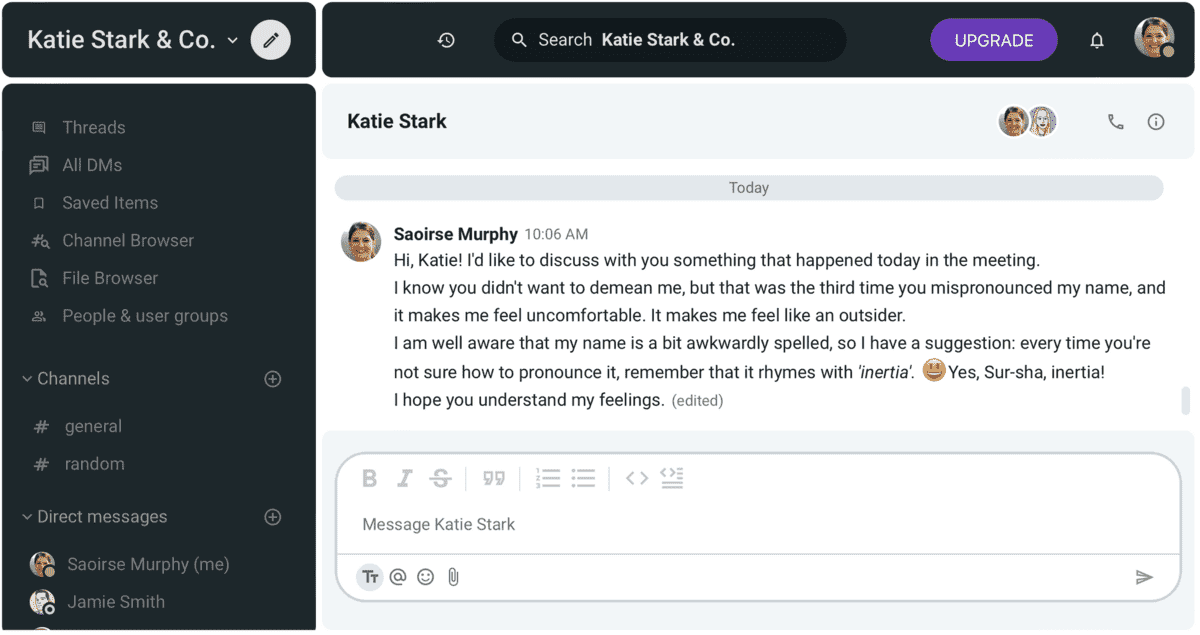
Resolve issues quickly over Pumble
She’s not criticizing her manager, Katie, but rather Katie’s microaggression. Aside from that, she’s even offering a quick solution to the problem.
Tip #3: Pick your battles
Although people from privileged backgrounds might think that marginalized people are overreacting when it comes to microaggressions, that can’t be further from the truth.
Namely, most members of marginalized groups ignore the majority of microaggressions because dealing with each one of them would be exhausting.
On the other hand, psychologists say that responding to microaggressions might be empowering.
Still, the question remains — how do you decide which battles to fight?
That is precisely why Dr. Kevin L. Nadal developed a Guide to Responding to Microaggressions.
In there, he offers a list of 5 questions you should ask yourself when considering whether to respond to a microaggression:
- “If I respond, could my physical safety be in danger?
- If I respond, will the person become defensive, and will this lead to an argument?
- If I respond, how will this affect my relationship with this person?
- If I don’t respond, will I regret not saying something?
- If I don’t respond, does that convey that I accept the behavior or statement?”
This useful tool will help you reach a decision and pick your battles.
When you’re a witness
Have you heard of the bystander effect?
It’s when the presence of others discourages you from taking action against a bully.
The irony is that the greater the number of bystanders, the less likely it is that anyone would help a person in distress.
Still, you don’t have to succumb to this effect — you can be an ally.
Typically, an ally comes from a privileged social group but is a great supporter and advocate for marginalized groups.
In her TED Talk, Luvvie Ajayi Jones encourages us to embrace the uncomfortable and become the first domino. When the first domino falls, the rest will follow.
Let’s see how we can all be better allies to marginalized groups.
Tip #1: Educate yourself about microaggressions
Rule number 1 — know your enemy!
To be able to recognize these sometimes elusive offenses, you need to educate yourself about different forms of microaggressions.
Also, as microaggressions are most often unintended, some people might not even notice them.
One of the experts we’ve reached out to, Kimberly Lee Minor, President at Bandier, agrees that this is a good first step:

“Before becoming more aware in the workplace, you must understand what microaggressions are and why they are so damaging. I recommend doing some self-discovery to develop an empathetic approach to being and then educating yourself on what microaggressions are. Identifying them will be difficult initially because they are micro and might not mean much to those not directed to them. Marry your empathy and education and personalize it. It will make it much easier to identify at work and in life.”
So, you need to allow yourself to be more empathic and teach yourself to notice microaggressions around you.
💡 Pumble Pro Tip
Improving your emotional intelligence might come in handy on this journey, so if you need help with becoming a more empathic and self-aware ally, check out our blog post on emotional intelligence at work:
Tip #2: Make the invisible visible
After you’ve educated yourself and learned to notice microaggressions around you, the next thing you can do is make the invisible visible.
If a perpetrator is unaware of the microaggression they’ve committed — and the chances are they are — it’s your turn to speak up.
For starters, this simple sentence is enough: “What do you mean by that?”
Give the perpetrator a chance to explain themselves.
Kimberly Lee Minor advises:

“In a situation where you witness a microaggression, it is good practice to apologize to the targeted person and then ask the offender if you can speak to them and explain why it was offensive. Encourage the offender to apologize and check themselves for the motive.”
However, make sure you speak for yourself, not in the name of the target, as Janet Stovall suggests:

“Since you can’t speak for another person, focus on the impact it had on you — especially if you and the aggressor share the same in-group.”
So, instead of: “What you said is offensive to Black people.”, say: “What you said made me feel uncomfortable.”
This way, you’ll avoid the so-called savior complex — helping others in a self-serving manner that perpetuates racial bias and narratives of White superiority.
Tip #3: Reach out to your coworker who experienced microaggression
When microaggression happens, it’s important to validate your coworker’s feelings and experience.
So, confirm to a colleague that what they experienced really is inappropriate microaggressive behavior.
Don’t let them think they imagined it, and assure them they’re not being hypersensitive.
They’re probably used to second-guessing their every feeling, so this reassurance will certainly be welcome.
When you’re the perpetrator
You probably think this part doesn’t concern you.
You have egalitarian views and never commit microaggressions, right?
We hate to be the bearer of bad news, but — wrong!
The trouble is that microaggressions usually emerge from our unconscious biases against people who are different from us.
Of course, a rule of thumb is to work on your awareness of these biases and make sure you don’t make these kinds of mistakes.
However, the reality is that you probably have made them and possibly will in the future. To err is human, but that doesn’t mean you shouldn’t work on your mistakes and do your best not to repeat them.
So, what should you do when you commit a microaggression?
Tip #1: Take a breath and own up to the mistake
OK, the worst has happened — you committed a microaggression towards your colleague, and they called you out for it.
You might feel embarrassed, defensive, and stressed — which is normal.
The first thing you need to do is take a deep breath and calm yourself down.
The fact that you made a mistake does not make you a bad person. You just did or said something bad unwittingly.
Now’s the time to own up to your actions and take responsibility, says Desai:

“If one has committed a microaggression, it’s best to acknowledge it, take responsibility, and make a change. Request 1-1 DEI training, apologize, and move on.
Accountability must be prioritized, which ties into creating a more forgiving workplace and killing toxic corporate culture.”
Tip #2: Listen to understand
To fully redeem yourself in your coworker’s eyes, you need to make sure they feel heard.
We know it’s not easy to listen to criticism, but try to have an open heart and mind.
The individual you hurt with your microaggression might want to explain in detail why what you did or said was hurtful. If that’s the case, embrace this learning opportunity and make the most of the situation.
On the other hand, it’s completely understandable if they just want to point out to you that you should not say that word or do what you did.
The burden of education is not on your colleagues.
Listen to the colleagues you offended, but don’t expect members of marginalized communities to educate you.
Our contributor Kimberly Lee Minor highlighted this point:

“Microaggressions are formed from ignorance and based on stereotypes. If you are ready to learn and grow, you should first apologize. Secondly, make a note of what you said or did and why.
Note the person’s reaction, and do not do it again.”
💡 Pumble Pro Tip
Sharpening our listening skills can help us understand our coworkers better and see how our actions and words affect them. To get a head start, check out the following guides:
Tip #3: Acknowledge and apologize, but don’t overdo it
Last but not least, you need to say you’re sorry for what you said or did.
Communication experts claim that your apology has to include 3 elements. You need to:
- Address the hurtful comment or behavior,
- Acknowledge its impact on your colleague, and
- Commit to doing better.
Even though you didn’t have bad intentions, the impact is real, as noted by Janet Stovall:

“Acknowledge and apologize for the negative impact you had. Intent doesn’t matter, impact does.”
In the Pumble exchange below, Judith Debord, a new project manager at a mobile phone company, expresses her concerns about a microaggression that occurred in the meeting.
Her colleague John Bautista is surprised but grateful to her for trusting him enough to share her concerns.
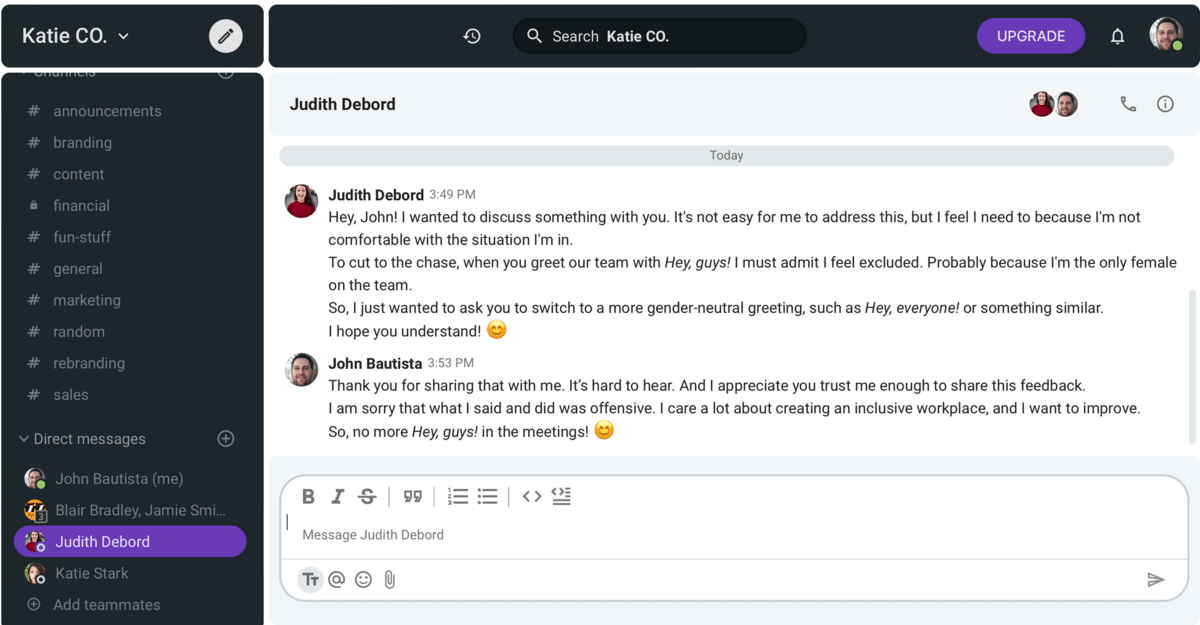
Give your communication a boost with Pumble
Additionally, when confronted with their transgressions, many people tend to over-apologize. This kind of behavior is counterproductive since it shifts the focus from the target to the perpetrator.
You should not expect your colleague to comfort you for your mistakes.
Let’s see what over-apologizing looks like in another example.
The situation is the same, but this time, John has a different reaction to Judith’s concerns about his microaggression.
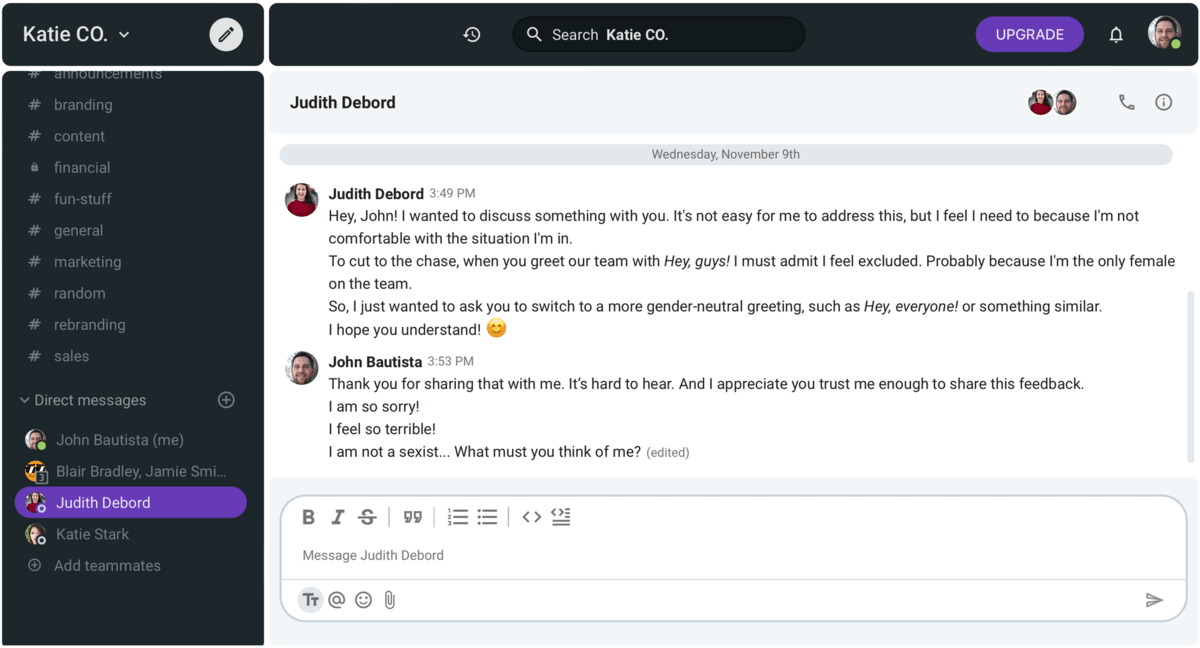
Long story short — apologize, but don’t overdo it.
Conclusion: Learn how to address microaggressions and create a more inclusive workplace
All of us can be perpetrators and witnesses, and many of us (if not all) can be targets of microaggressions in the workplace.
If we want a more inclusive workplace, we need authentic conversations about tough topics — that includes racism, homophobia, and sexism.
Once again, communication is key.
The more we talk about microaggressions and the more aware of them we are, the greater the chances for a workplace where all employees feel comfortable in their skin — regardless of its color.
✉️ What about you? Have you noticed any microaggressions in your workplace? How do they impact your workplace environment?
Do you have any additional tips on what to do when you witness microaggressions? Share your experience and tips at blogfeedback@pumble.com and we may include your answers in this or future posts.









